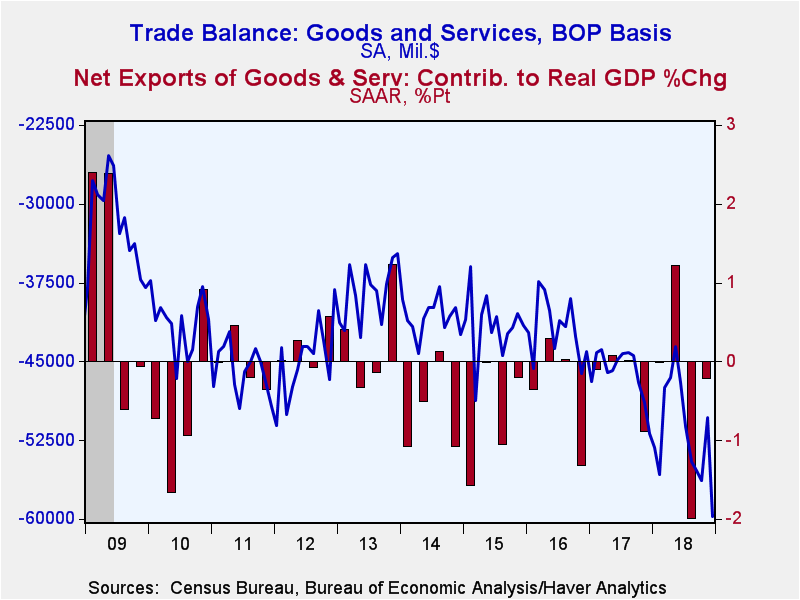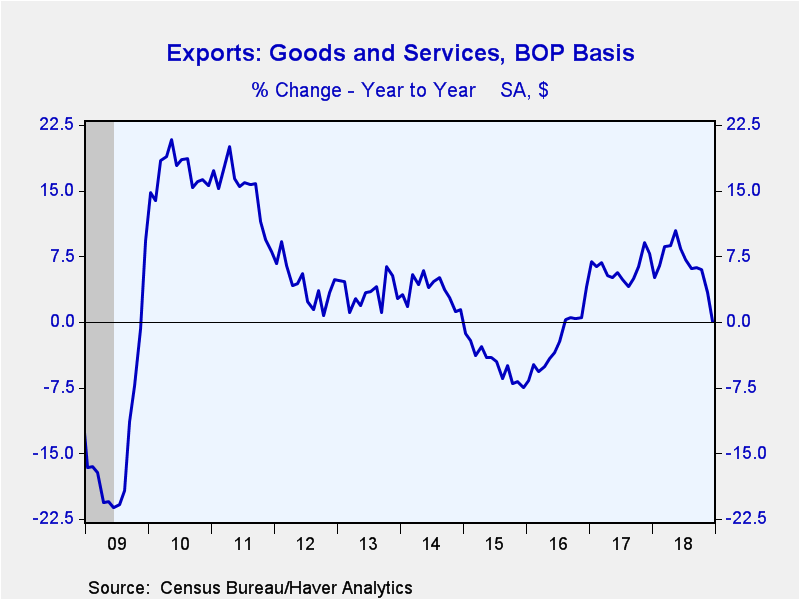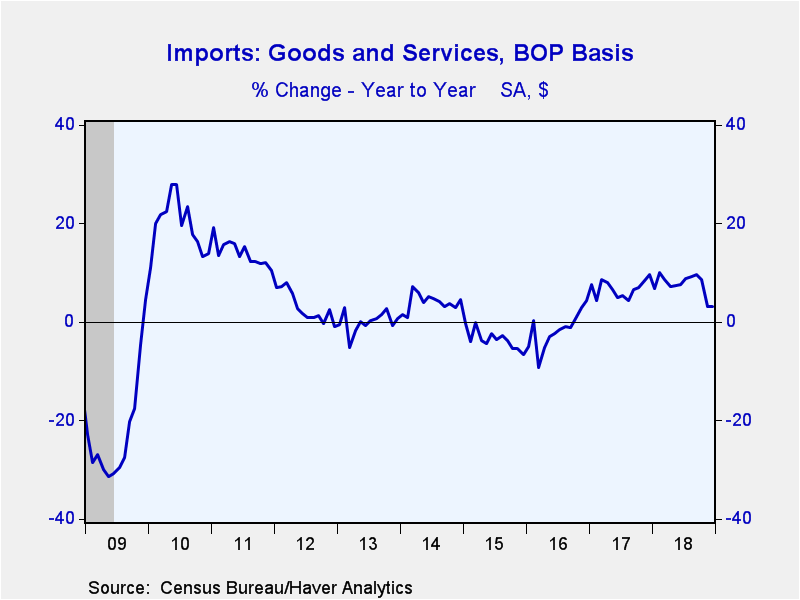 Global| Mar 06 2019
Global| Mar 06 2019U.S. Trade Deficit Widens to 10-Year High; Record Goods Shortfall
Summary
The U.S. trade deficit in goods and services widened more than expected to $59.77 billion in December from an upwardly revised $50.30 billion in November. This was the largest deficit since October 2008. The Action Economics Forecast [...]
The U.S. trade deficit in goods and services widened more than expected to $59.77 billion in December from an upwardly revised $50.30 billion in November. This was the largest deficit since October 2008. The Action Economics Forecast Survey anticipated a $57.8 billion deficit. The trade deficit has increased in six of the last seven months, with the sole exception being November. Exports dropped by 1.9% (+0.1% year-over-year), while imports jumped 2.1% (3.1% y/y) in December.
For the entirety of 2018 the trade deficit widened to $621 billion from $552 billion. The nonpetroleum trade deficit hit a record $568 billion in 2018 (data goes back to 1992). The larger-than-expected trade deficit in December as well as upward revisions to previous months suggest that trade will be a larger drag on the fourth quarter than the -0.2% estimate in last week's GDP report.
The deficit in goods trade increased to a record $81.54 billion in December from $72.55 billion. Exports of goods fell 2.8% (-0.8% y/y), led by a 3.5% drop in capital goods (-0.7% y/y). Foods, feeds and beverage exports were down 1.6% (-11.6% y/y). Autos edged down 0.1% (-8.8% y/y), while nonauto consumer goods ex. food grew 0.7% (2.0% y/y). Industrial supplies (which include oil) powered down 4.6% (+2.3% y/y) driven by a 12.1% plunge in petroleum as both the price and quantity of exports fell.
Imports of goods rose 2.4% (3.4% y/y) in December. Capital and consumer goods as well as foods, feeds and beverages experienced strong growth of 4.8% (5.1% y/y), 4.5% (1.0% y/y) and 3.6% (6.1% y/y) respectively. Both auto and industrial supplies imports edged up 0.1% in December (4.8% y/y and 1.5% y/y). Petroleum imports fell 8.5% (-5.6% y/y) as oil prices dropped.
The surplus on services trade decreased to $21.77 billion in December from $22.26 billion. This is the fourth consecutive monthly decline in the services surplus. Services exports were unchanged (+1.8% y/y) while imports rose 1.0% (2.0% y/y).
The real (inflation-adjusted) goods trade balance widened to a record $91.6 billion (chain weighted 2012$) in December from $81.6 billion in November (series goes back to 1994).
The politically sensitive goods trade deficit with China rose to $38.7 billion (seasonally adjusted) in December. This is the largest deficit recorded outside of the port-strike-related $40.5 billion reading in March 2015. For all of 2018, the goods trade deficit with China ballooned to a record $418 billion from $376 billion. U.S. exports to China jumped 6.0% in December (-34.1% y/y) after dropping a cumulative 28.5% in the previous two months. Imports rebounded 8.5% (2.7% y/y) after falling a cumulative 10.2% in October and November.
The international trade data as well as oil prices can be found in Haver's USECON database. Detailed figures on international trade are available in the USINT database. The expectations figures are from the Action Economics Forecast Survey, which is carried in AS1REPNA.
| Foreign Trade in Goods & Services (Current $) | Dec | Nov | Oct | Dec Y/Y | 2018 | 2017 | 2016 |
|---|---|---|---|---|---|---|---|
| U.S. Trade Deficit ($ bil.) | 59.77 | 50.30 | 56.30 | 51.89 (12/17) |
621.04 | 552.28 | 502.00 |
| Exports of Goods & Services (% Chg) | -1.9 | -0.7 | -0.1 | 0.1 | 6.3 | 6.1 | -2.2 |
| Imports of Goods & Services (% Chg) | 2.1 | -2.8 | 0.3 | 3.1 | 7.5 | 6.8 | -1.7 |
| Petroleum (% Chg) | -8.5 | -14.4 | -2.7 | -5.6 | 21.0 | 27.2 | -19.5 |
| Nonpetroleum Goods (% Chg) | 3.4 | -2.4 | 0.4 | 4.1 | 7.5 | 5.6 | -1.2 |
Gerald D. Cohen
AuthorMore in Author Profile »Gerald Cohen provides strategic vision and leadership of the translational economic research and policy initiatives at the Kenan Institute of Private Enterprise.
He has worked in both the public and private sectors focusing on the intersection between financial markets and economic fundamentals. He was a Senior Economist at Haver Analytics from January 2019 to February 2021. During the Obama Administration Gerald was Deputy Assistant Secretary for Macroeconomic Analysis at the U.S. Department of Treasury where he helped formulate and evaluate the impact of policy proposals on the U.S. economy. Prior to Treasury, he co-managed a global macro fund at Ziff Brothers Investments.
Gerald holds a bachelor’s of science from the Massachusetts Institute of Technology and a Ph.D. in Economics from Harvard University and is a contributing author to 30-Second Money as well as a co-author of Political Cycles and the Macroeconomy.









